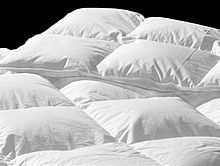- Duvet
-
For the song by Bôa, see The Race of a Thousand Camels.
A duvet (pronounced UK: /ˈduːveɪ/, US: /duːˈveɪ/) (also known as a doona in Australian English and a dyne in Scandinavian from which the Australian word was derived) from the French duvet [dyˈvɛ] "down"), is a type of bedding — a soft flat bag filled with down, feathers, or a synthetic alternative, and protected with a removable cover, analogous to a pillow and pillow case. Duvets originated in rural Europe and were made from the down feathers of the eider duck, known for its usefulness as a thermal insulator.
Contents
History
In the mid-eighteenth century, Thomas Nugent, an Englishman on a grand tour then passing through Westphalia, observed with surprise:
- "There is one thing very particular to them, that they do not cover themselves with bed-cloaths, but lay one feather-bed over, and another under. This is comfortable enough in winter, but how they can bear their feather-beds over them in summer, as is generally practised, I cannot conceive." — The Grand Tour 1749, vol II. p. 66
Description
Duvets reduce the complexity of making a bed, as it is a single covering instead of the combination of bed sheets, blankets, and quilts or other bed covers. The duvet itself fits into a specially made cover, usually of cotton or a cotton blend. The duvet cover is removed and laundered as often as the bottom sheet and pillow cases. The duvet itself may be cleaned much more rarely, and depending on its contents, may require specialist dry cleaning.
A modern duvet, like a sleeping bag, may be filled with down or feathers of various quality and cost, or silk, wool, cotton, or artificial fibers such as polyester batting.
A duvet is not to be confused with a comforter. Although comforters go on top of the traditional sheets and blankets, duvets are used by themselves.
Regional variations
Duvets are the most common form of bed covering, especially in northern Europe. They became popular throughout the world in the late 20th century.
"Continental quilt" was the term used when the item was widely introduced into England during the early 1970s.
Originally this was the standard name used across Australia. Now, however, particularly in eastern regions, a duvet is often called a "doona", which is the brand name created by Kimptons (Northern Feather). The Tontine Group acquired the trademark in 1991 when Pacific Dunlop took over the company. "Doona" is derived from the equivalent common Scandinavian term dyne and was popularized by the retailer IKEA in the 1970s.
In India and Pakistan, duvets are known as "ralli quilts" or razai, and are mostly used in the southern province of Sindh.
In the US, confusion often occurs as the word "duvet" is sometimes used to refer to a comforter cover rather than the down blanket itself.
In some European countries, any thick, warm blanket may be called a duvet.
Standards and sizes
Main article: Bedding#Bedding_sizesModern manufacturing conventions have resulted in a large number of sizes and standards.
Thermal performance (tog rating)
Manufacturers rate the performance of their duvets in togs, a measurement of thermal insulation. This enables the purchaser to select a duvet appropriate to the season: the higher the tog rating, the warmer the duvet.
A few manufacturers have marketed combined duvet sets, one of approximately 4.5 tog and one of approximately 9.5 tog. The light-weight one is for summer and the medium one for autumn; snapped together, 14 togs is designed for winter.
Influence on popular culture
The term "duvet day" is used in some countries to describe an allowance of one or more days a year when employees can simply phone in and say that they are not coming in to work, even though they have no leave booked and are not ill. The provision of this benefit became fashionable in the late 1990s with many larger companies in the UK.[1]
See also
Notes
- ^ "Duvet", Wordspy.com, webpage: Word Spy - duvet day
External links
- "Mina" (2002-02-05). "How to fit a Duvet Cover: The One-minute Guide". BBC. http://www.bbc.co.uk/dna/h2g2/brunel/A681329.
- "Shawn" (2011-01-06). "Duvet Care Tips". Beddingtons. http://www.beddingtons.com/newsletters/2010/bb-9/index_B.html.
Bedding Bed types Bassinet · Box-bed · Bunk bed · Cage bed · Camp bed · Canopy bed · Couch · Couch bed · Four poster bed · Futon · Hammock · Hospital bed · Infant bed · Lit a la turque · Manjaa · Murphy bed · Petate · Platform bed · Sleigh bed · Sofa bed · Toddler bed · Trundle bed · Waterbed · DaybedBed components Air mattress · Bed base · Bed frame · Bed skirt · Bed warmer · Box-spring · Bunkie board · Cot side · Featherbed · Headboard · Mattress · Mattress pad · Mattress protector · Memory foam · Nightstand · Orthopedic mattress · SheetBlankets Afghan · Button blanket · Comforter · Duvet · Electric blanket · Fire blanket · Hudson's Bay point blanket · Patchwork quilt · Photo blanket · Pierzyna · Quilt · Security blanket · Silk comforterPillows Acupressure pillow · Bamboo wife · Bolster · Contour leg pillow · Cushion · Dakimakura · Eye pillow · Love pillow · Orthopedic pillow · Phonetic pillow · Sex pillow · Speaker pillow · Throw pillow
Categories:
Wikimedia Foundation. 2010.

